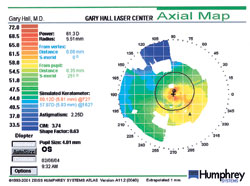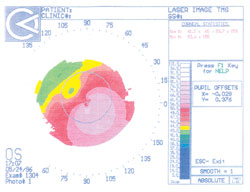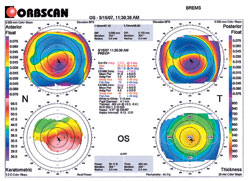Case report: Keratoconus successfully managed with aspheric GP lens fit, lifestyle changes
Click Here to Manage Email Alerts
This case presentation suggests that severe keratoconus can be improved by using aspheric gas-permeable contact lenses in a superior-to-intermediate corneal alignment fit, and that visual therapy and nutritional supplementation may also play a role.
I was taught to fit GP contact lenses utilizing topography by Dr. Leonard Bronstein, who, in the 1950s, was a student of Newton Wesley, OD, a keratoconic patient who had worn a flat superior alignment fit successfully well into his 90s. Since then, I have long been a disciple of the “big picture” philosophy, incorporating a holistic approach to managing keratoconus by optimizing lens design, accommodative function and nutritional supplementation.
Case report
In this particular case, my patient initially demonstrated significant improvement in her keratoconic corneal topography profile, shown in the accompanying figures, only to experience a decline in her overall systemic health due to poor diet, lack of exercising balance and flexibility, and stress.
 Images: Eger JJ  |
|
After adopting a healthier diet (no red meat, more fruits and vegetables and dietary supplementation) and lifestyle, my patient’s mood and physical stature improved dramatically. Concomitantly, I witnessed an improvement in her corneal topographies. In fact, the flattening effect was significant enough to warrant contact lens refitting, as her present contacts, which had been stable for more than 5 years, had become steep and tight.
My patient’s current contact lens parameters for the right eye, which has dormant keratoconus, are: an Apex (X-Cel) or aspheric cone lens with Boston XO material, UV blue, 7.85 radius, +2.00 D, 9.2 mm diameter and medium edge lift. The parameters for the left eye, which has aggressive keratoconus, are an Apex lens with Boston XO material, UV blue, 8.44 radius, +8.75 D, 9.7 mm diameter and medium edge lift. This represents the flattest aspheric GP contact lens-to-cornea fitting relationship I have ever prescribed.
  |
|
We started steeper in base curve, conventionally, and progressively went flatter in base curve in +0.50-D steps during progress checks to rid the trapping of an air bubble behind the lens and any superficial punctate keratitis.
Currently she enjoys best-corrected visual acuity of 20/25+2 OS and 20/20+4 OD, light apical touch in both eyes, a well centered lens with good tear exchange in both eyes and a cornea devoid of superficial punctate keratitis, 3 o’clock and 9 o’clock corneal staining and apical scarring. She wears her contacts comfortably 15 or more hours a day.
I believe that this type of corneal alignment fitting process provides a healthier outcome than merely attending to the apex of the cone. While I realize that this is just one patient, the corneal topography maps certainly corroborate my observations. Her Orbscan pachymetry and OCT indicated that the center thickness is fairly normal for keratoconus with this flatter fitted aspheric cone GP.
Accomplishing this sort of fitting relationship is critical, as it has long been hypothesized that keratoconic corneas are more malleable than non-keratoconic corneas. Early on it was felt that this was the reason for low IOPs in patients with keratoconus.
I have personally witnessed this phenomenon, as I have a database of 403 keratoconic eyes with applanation IOPs of between 7 mm Hg and 12 mm Hg. We now know that the lower IOPs are at least partially a function of the thinner corneal thickness profiles encountered with this condition. However, corneal hysteresis studies do corroborate the inherent “softness” of keratoconus, and this is the basis for corneal collagen cross-linking studies.
The challenge for us as contact lens clinicians is to stabilize the keratoconic cornea. It is my impression that this requires not only an optimal fitting relationship, but minimizing corneal “stress” as well. This is why avoiding eye rubbing is so important for our keratoconic patients.
My prepresbyopic patients wear +0.50 D or +0.75 D reading glasses over their GP lenses. They are instructed to take a break after 1 to 2 hours of reading or computer work to look far away, rock accommodatively far to near, scan, observe the periphery and do simple yoga exercises to relax the neck and shoulders in the chair. I have found that when using vision therapy, exercise, stretching and nutrition with raw vegetables and fruit we do fewer refits than before.
Effect of diet
I was intrigued by the dramatic improvement this patient experienced with nutritional balancing. Can a diet rich in fiber, vitamins, antioxidants and other nutrients provide the cornea with much needed essentials? It is my hypothesis that these food sources provide essential enzymes necessary to curb cellular damage and keratocyte apoptosis.
My patient, who was on a corneal transplant list 13 years ago, has been so pleased with her improvements that she launched her own Web site to assist fellow keratoconus sufferers. While I do not agree with her title (“How I regressed keratoconus”), she feels it is appropriate. Go to her Web site, healingkeratoconus.tripod.com, to read her journey.
For more information:
- Jeffrey J. Eger, OD, FIOS, can be reached at 1106 W. University Dr. #1, Mesa, AZ 85201; e-mail: drjeffeger@cox.net; Web site: www.allamericansportsvision.com. Dr. Eger has no direct financial interest in the products mentioned in this article, nor is he a paid consultant for any companies mentioned.
- KC Global is the International Keratoconus Foundation, supporting keratoconus research, education, advocacy and service. They can be reached at www.kcglobal.org.
